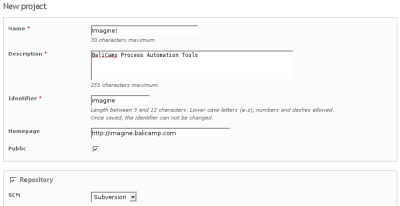

#Bitnami redmine default admin password update
Remember to make sure the MariaDB database password matches the Redmine.Ī full walkthrough including advanced configuration topics can be found here: USE mysql UPDATE USER SET password password('Note: When modifying the default values in values.toml remember to run "helm generate redmine" before installing. Configuring Redmine to use SMTP (email).Setting the Redmine admin user and password.The Bitnami Redmine chart has been designed with this in mind and provides a range of customization options including: Helm supports customizing applications by editing and regenerating them before installing. One of the great features of Kubernetes and Helm is the ability to customize and configure each application deployment. The default username and password are "user" and "bitnami"ĭigging Deeper - customizing your application deployment To access Redmine type the “Load Balancer Ingress” address into your web browser: To access the running Redmine application we need to know the IP address of the Kubernetes load balancer: The Redmine pod will show a ready count of 1 / 1, as shown above, when redmine has finished launching. Redmine will take a minute or two to start, the ready count shows when the application has started: Once MariaDB has been deployed we can deploy the Redmine application First we'll create an MariaDB database instance for Redmine to use: bnlimesurvey, bitnamilimesurvey, , lime. In the Server-Log i can find this: Wed Oct 26 10:01: Setting up password for limesurvey application. Tried ‘admin’ / ‘password’ which should be default for LimeSurvey but it is incorrect. Collections of charts are organized into repositories so our first step is to add the Bitnami chart repository to helm:Ģ. Works great but i cannot find the default password (and default user) for the admin area.
#Bitnami redmine default admin password how to
Helm uses charts to describe how to deploy a particular applications and their metadata. You’ll need a copy of the helm package manager for Kubernetes for your platform.

There are many deployment options for Kubernetes as documented here ( ) Particularly if you’re new to Kubernetes we recommend starting with Google Container Engine ( )

You’ll need to setup a Kubernetes cluster. If you don’t remember your MariaDB root password, you can follow the steps below to reset it to a new value: Create a file in /tmp/mysql-init with the content shown below (replace NEWPASSWORD with the password you wish to use): For versions lower than 10.4: UPDATE er SET PasswordPASSWORD ('NEWPASSWORD') WHERE User'root' FLUSH. This tutorial is aimed at developers and operators interested in learning about containerizing applications on Kubernetes and looking for solutions to common concerns including configurability, application state, and health monitoring. Remember to make sure the MariaDB database password matches the Redmine. This post walks through configuring and deploying a widely used web application, the Redmine issue tracking application, packaged as Docker containers. Changing the default MariaDB password Setting the Redmine admin user and password Configuring Redmine to use SMTP (email) Configuring the Redmine UI language Note: When modifying the default values in values.toml remember to run 'helm generate redmine' before installing. Yesterday i have migrated from redmine 1.4.x to redmine 2.0.3 and realized that the CAS plugin don't work on redmine 2 ( ) ! So i have'nt CAS authentication and I did't have an admin work local account !!įound in file /app/models/user.Kubernetes, a popular Docker container orchestration platform, promises to make deploying and managing containerized applications simple.


 0 kommentar(er)
0 kommentar(er)
